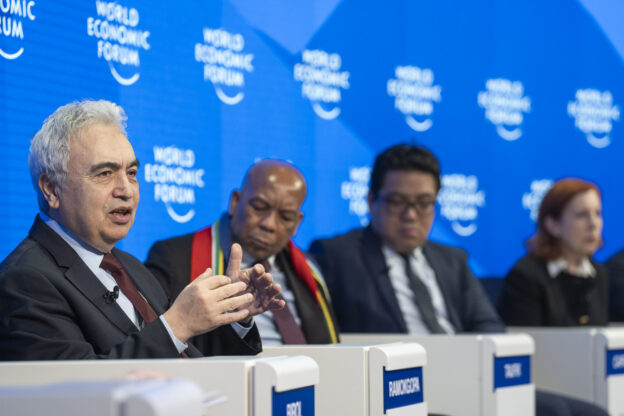- Countries are investing heavily in clean energy but are taking different paths based on their unique political, technological and financial circumstances.
- Successful energy transitions require partnerships between governments and private companies.
- This article was first published in Devex, read it here.
From China’s nearly $700 billion investment in energy transition in 2023 to Brazil’s fast-tracked green patents, countries are racing to transform their energy systems – but through starkly different paths. This global shift isn’t just about swapping fossil fuels for renewables. It’s sparking system-wide changes that are reshaping industries, economies and societies in profoundly different ways across regions.
These transformations are influenced by political, technological, human and financial realities that vary significantly across geographies. Despite these diverse experiences, they reveal shared opportunities for collaboration and distinct lessons for accelerating the clean energy transition worldwide.
Success requires transforming both energy production and consumption patterns while integrating digital tools and emerging technologies across energy value chains. Global examples offer valuable lessons for all and opportunities to collaborate across companies and regions.
Industrial innovation in action
The United Kingdom government and a consortium led by energy tech company Eni are working on some of the world’s first asset-based regulated carbon capture, utilization and storage, or CCUS, projects to capture, transport and store carbon dioxide (CO2) emissions. The government has committed £21.7 billion (about $27 billion) to CCUS projects nationwide.
The first of these, the HyNet North West project will repurpose depleted reservoirs in Liverpool Bay, transforming one of the country’s most energy-intensive regions into a low-carbon industrial hub.
The model aims to de-risk major infrastructure projects and provide the certainty needed to attract private investment and capture approximately 10 million metric tons of CO2 annually after 2030, contributing to the national target of 20–30 million tons annually by 2030.
HyNet is expected to generate £17 billion in economic benefits by 2050 through job creation, industrial decarbonization and ensuring long-term competitiveness. Eni’s planned expansion into a project in the southeast of the country further highlights the scalability of this model, emphasizing the importance of public-private collaboration for the energy transition.
An R&D leadership race
Several countries are investing heavily in clean energy research, aiming to become global technology suppliers rather than just adopters.
Take China – its $4 billion to over $6 billion annual spend on clean energy research and development in recent years has created a solar industry that leads the world in terms of capacity and feeds it in terms of technology.
China opened the world’s first small modular reactor in 2023 after its push to pioneer these “fourth-generation” units saw its share of global nuclear patents rise from 1.3% in 2008 to 13.4% in 2023. A similar story is emerging in energy storage, with China accounting for one-third of the global market thanks to a targeted policy pursuing 30% cuts in storage costs.
Brazil’s Green Patents programme, meanwhile, is fast-tracking patent applications related to environmentally beneficial technologies. Launched in 2012, it has cut average decision times on applications from three-and-a-half years to nine months – eradicating delays that were impeding research and development (R&D) funding and the energy transition.
The United Arab Emirates has also bolstered R&D – both in a forthcoming climate change law and its Energy Strategy 2050. Fifteen years of supporting solar R&D has cut costs significantly – as much as 85% in Dubai – making installing solar 48% cheaper in the UAE than the worldwide average.
”
Building global collaboration
Chile’s long tradition of bilateral agreements has delivered concrete results in developing renewable energy and a methane capture programme, particularly through its partnership with Germany. The Chilean-German collaboration has fostered sustainable energy practices from knowledge exchanges to a deal to export Chilean renewable hydrogen to Hamburg.
Germany has provided Chile with $9.76 million for e-fuel development under the initiative, helping the rapid market growth that has positioned Chile as a premier destination for renewable investment – it attracted $3.4 billion in 2021, leading to renewables accounting for 55.1% of power generation in 2022.
Egypt’s clear renewable energy targets and the 2014 Renewable Energy Law have made it the world’s second-highest recipient of foreign direct investment in renewables as of 2022.
The country has allocated land for private wind and solar development and negotiated an innovative debt swap with Germany, converting $55 million of debt into renewable energy and grid modernization funding.
Efficiency drives change
The International Energy Agency describes energy efficiency as the “first fuel” in clean energy transitions. India provides a shining example – literally – with its work to push households toward LED light bulbs. Within four years, bulb swap programmes and large-scale procurement tenders raised their LED market share from 10-15% to 75%.
Indian multinational Mahindra has also incorporated LEDs to increase its energy efficiency in automotive manufacturing. While LEDs represent a relatively small part of a wider strategy – which also includes installing advanced technology such as heat-recovery systems and hybrid solar panels – these combined efforts helped the company improve its energy efficiency by 95% between 2009 and 2023, reducing emissions by 11,000 tons of CO2 equivalent. The company saved over $1.15 million from an initial investment of just $900,000.
Accelerating progress
While each country must chart its own energy transition course, successful approaches share common elements: clear targets, supportive policies, public-private collaboration, and innovative financing. The examples from China, Brazil, Chile and others show how different strategies can accelerate progress toward sustainable, secure and equitable energy systems.
As countries find their paths toward their transitions, some will go faster than others, some will innovate and others will learn from and build on those innovations. There is no single formula for success but there are critical commonalities. Leveraging these is how countries will transition in a way that drives sustainability and also offers significant social benefits, business opportunities and economic growth.
https://www.weforum.org/stories/2025/02/clean-energy-success-demands-country-specific-solutions/?utm_source=sfmc&utm_medium=email&utm_campaign=2847689_ForumStories-7March2025&utm_term=&emailType=Forum%20Stories





